- COTTICE(S) (COTISE(S) or COST)
- A heraldic term for a narrow band, stripe or bendlet (or two or more) on either side of a charge, but separated from it by a narrow strip (or strips) of field - usually only applied to a bend, but sometimes also to fess, pale, and chevron.
- See also ‘cotticed 1)’ below).
![[example]](../images/v/vxt-d1164a.gif)
![[example]](../images/v/vxt-d1164c.gif)
- COTTICED (COTISED or COTIZED)
- 1) On flags, a term that may be used to describe the addition of one or more
narrow stripes or bands to an existing charge (such as a stripe or cross) but
which is separated from that charge by a strip of field – but see note below.
- 2) The alternative heraldic terms used when one (or two or more) narrow band(s),
stripe(s) or bendlet(s) appear on either side of a charge, but separated from it
by a narrow strip of field – cotised or cotized –
see ‘cottice(s)’
plus notes b) and c) below.

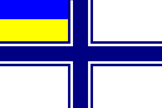
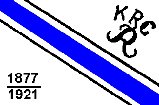
Flag of Bělá u Jevíčka, Czechia (fotw);
Navy Flag c1920, Ukraine (fotw);
Flag of Koblenzer Rowing Club, Germany (fotw)
Notes
a) With regard to 1), where the field is not shown between the charge
and the cottice (as illustrated below) it should be described as double or triple fimbriated as appropriate
(see also ‘fimbriation 1)’).
b) Regarding 2), these terms are usually only applied to a bend, but sometimes also to a fess, pale or chevron, and in addition
c) have a rather more restricted/complex use than has been briefly described above, it is
therefore suggested that a suitable glossary or dictionary of heraldry should be consulted for further details.
- COTTICES (or COTISES)
- The alternative heraldic terms used to describe two or more narrow bands or stripes on either side
of a charge as for cost – usually only applied to a bend but also sometimes to
other charges (see cost/cottice).

- COUCHANT
- The heraldic term used when an animal (most often – but not invariably – a
lion) is depicted as lying down, with its head generally facing towards the dexter
– but see ‘sejant’ and the note below (also ‘heraldic beasts’).
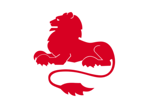
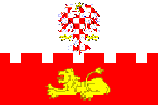

Flag of Rødøy, Norway (fotw);
Flag of Uhersý Brod, Czechia (fotw);
Flag of Pedrógão Pequeno, Portugal (fotw)
Please note that the visual difference between sejant and couchant is often
difficult to determine, and we suggest that the official blazon be followed in each
individual case.
- COUNTER-
- The heraldic prefix used when two charges on a shield, banner of arms or flag are turned in contrary directions
as in “fleuri-counterfleuri” (see ‘double-tressure fleury counter fleury’), or when two
tinctures are reversed either side of a line or lines drawn through a coat of arms see
‘counterchanged’ (also
‘counterchanged cross’ and
‘counter-compony’).
- COUNTER-COMPONY
- An abbreviation of the heraldic term compony counter-compony used when an
ordinary or border is composed of two rows of squares (or occasionally
rectangles) in alternating tinctures – see ‘counter-’ above and
‘compony’
(also ‘checky 1)’,
‘checky 2)’,
‘counterchanged’ below,
‘ordinary’ and
‘tincture’).
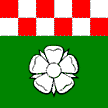
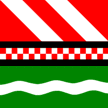
Flags of Olsberg and Niederwil, Switzerland (fotw)
- COUNTERCHANGED (or COUNTER-CHANGED)
- (adj) A heraldic term used to describe two colours alternating either
side of a line or lines drawn through a flag or coat of arms or charge – counter-changed or parti-coloured
(see also ‘charge’,
‘coat of arms 2)’
‘counter-’,
’counterchanged cross’,
‘counter-compony’ above
and ‘faceted’).
![[Greenland]](../images/v/vxt-d101a.gif)
![[counterchanged]](../images/v/vxt-d4768.gif)
![[Tas-Sliema, Malta]](../images/v/vxt-d1963.gif)
Flag of Greenland (fotw);
Flag of Trey, Switzerland (fotw);
Flag of Tas-Sliema, Malta (fotw)
- COUNTERCHANGED CROSS
- In heraldry see ‘cross counterchanged’.
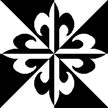
Putative Banner of the Dominicans (fotw)
- COUNTY ARMS (or COAT OF ARMS)
- See ‘civic arms 2)’.
![[county arms]](../images/v/vxt-d4285.gif)
![[county arms]](../images/v/vxt-d4286.gif)
Arms of the County of Kent, UK (fotw);
Arms of the County of Somerset, UK (fotw)
- COUNTY FLAG
- See ‘sub-national flag’ (also
‘civic flag 2)’.
![[Wayne county flag]](../images/v/vxt-d3624.gif)
![[Essex county flag]](../images/v/vxt-d3625.gif)
Flag of Wayne County, Michigan, US (fotw); Flag of the /county of
Essex, UK (fotw)
- COUPEAU (or COUPEAUX)
- The alternative French heraldic terms for the base of a shield, banner of arms or a flag that is composed of
semi-circular mounds, and is intended to represent (usually) three (but up to six) hills –
a coupeau of two, three, four, five or six, mount of coupeau, doublemount or threemount –
see ‘compartment’ (also ‘mount’).

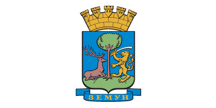
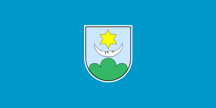
Flag of Kachkanar, Russia (fotw);
Flag of Zemun, Serbia (fotw);
Flag of Ludbreg, Croatia (fotw)
- COUPEAU OF THREE (or COUPEAUX OF TWO, FOUR, FIVE or SIX)
- See ‘coupeau’ above.
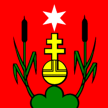

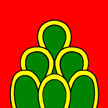
Flag of Oberrohrdorf, Switzerland (fotw);
Flag of Villarbeney, Switzerland (fotw);
Flag of Courtételle, Switzerland (fotw)
- COUPED (or COUPÉE)
- 1) The heraldic terms used when a charge is cut off in a straight line as is often the case with the
heads and limbs of animals but see 2) below
(also ‘erased’).
2) Heraldic terms that are also used when an ordinary or charge does not extend to
the edges of a shield or banner of arms, for example a cross-couped or cross coupée.
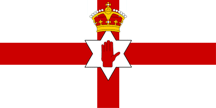


Unofficial Flag of Northern Ireland (fotw); Flag
of
Andwil, Switzerland (fotw); Flag of the
ICRC (fotw)
- COURANT (CURRENT or CURSANT)
- Alternative heraldic terms used to describe an animal running at full speed – current or cursant.


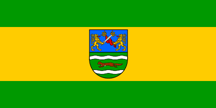
Flag of Pinelo, Portugal (fotw);
Arms of Caçarelhos e Angueira, Portugal (fotw);
Flag of Požega-Slavonia, Croatia (fotw)
- COURTESY FLAG
- That flag (normally, but not exclusively, the national flag of the country
being visited) flown from a prominent position on a merchant vessel as a matter
of courtesy when visiting a foreign port – a complimentary flag (see also
‘yardarm’).
- COVERING
- 1) The term used when a canton, charge or emblem obscures the entire width of a stripe or stripes on a multi-striped flag,
and in the case of a canton usually (but not invariably) at the hoist –
encroaching upon (see also ‘canton 2)’,
‘multi-stripe’ and
‘overall 1)’ and
‘partially covering’).
-
2) A term that is also used when an emblem or charge occupies the entire
width within a stripe (see also ‘stripe(s)’ and
‘width 2)’).
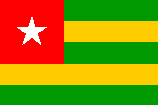
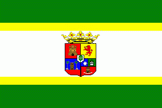
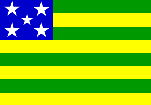
National Flag of Togo (fotw);
Flag of Teror, Spain (fotw);
Flag of Goiás, Brazil (fotw)
Notes
a) An example of 1) would be a square or rectangular canton covering the first three stripes, as
illustrated above, also:
b) Under these circumstances the term is never used alone but always with the number of stripes being covered.
- COWARD/COUARD
- The heraldic terms used when an animal is shown with its tail between the hind legs – couard – but see the note below (also ‘double queued’ and ‘queued’).
![[coward]](../images/v/vxt-d4166.gif)
![[coward]](../images/v/vxt-d1109.gif)
![[coward]](../images/v/vxt-d5281.gif)
Flag of Leuk, Switzerland (fotw);
Flag and Arms of Paršovice, Czechia (fotw);
Flag of Turtmann-Unterems, Switzerland)
Please note that in English heraldry the display of an animal (particularly a lion) with its tail between its legs can be a symbol of cowardice or dishonour – see ‘abatements’.
![[coward]](../images/v/vxt-d4167.gif)
Lion coward/couard denoting cowardice or dishonour (Wikipedia)
- COWED
- An alternative heraldic tern to queued – see ‘queued’.
![[cowed]](../images/v/vxt-d2859.gif)
Flag of Schleiden, Germany (fotw)






![[Greenland]](../images/v/vxt-d101a.gif)
![[counterchanged]](../images/v/vxt-d4768.gif)
![[Tas-Sliema, Malta]](../images/v/vxt-d1963.gif)

![[county arms]](../images/v/vxt-d4285.gif)
![[county arms]](../images/v/vxt-d4286.gif)
![[Wayne county flag]](../images/v/vxt-d3624.gif)
![[Essex county flag]](../images/v/vxt-d3625.gif)















![[coward]](../images/v/vxt-d4166.gif)
![[coward]](../images/v/vxt-d1109.gif)
![[coward]](../images/v/vxt-d5281.gif)
![[coward]](../images/v/vxt-d4167.gif)
![[cowed]](../images/v/vxt-d2859.gif)

![[example]](../images/v/vxt-d1164a.gif)
![[example]](../images/v/vxt-d1164c.gif)


